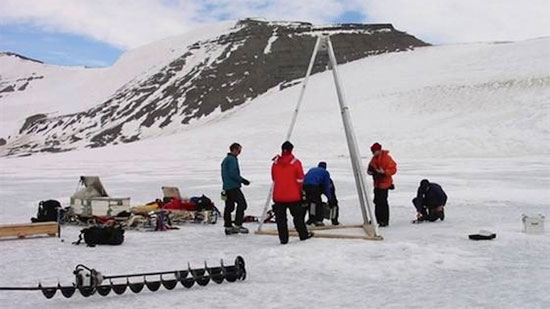Detecting signs of life in the bottom of the Antarctic lake
Researchers have found signs of life in the mud taken from the bottom of an Antarctic glacier.
Researchers from the Antarctic survey center, together with a number of other research institutes, have drilled the thick ice above Lake Hodgson, located in the Antarctic peninsula, about 93m deep, to collect samples. Clean sediment below.

Scientists are drilling the ice above Lake Hodgson in Antarctica to study samples of sediments at the bottom - (Photo: LiveScience)
Currently, the ice above the lake is only about 3-4m, but thousands of years ago, the upper ice layer of the lake was up to 500m. Researcher David Pearce of Northumbria University said: 'This is the first time scientists have been studying the layers of sediment beneath the ice-filled reservoir.'
Analyzing the sediment samples, scientists found signs of life, dating from nearly a 100,000 years. Pearce and his colleague said they had implanted 20 types of bacteria found in the top layer of sediment core, resulting in strong growth in harsh environments. In addition, he found many DNA fossils of many different types of bacteria, who have lived in adapting to the Antarctic climate for a long time.
The researchers also said that about a quarter of the genes identified are not suitable for any known gene sequence. This shows very much the possibility that these species in this isolated ecosystem may be new to scientists.
Pearce said understanding how bacteria and other forms of life are thriving in cold, dark weather, where isolation and poor nutrition under frozen continental ice can help homes. study about the origin of life on Earth and the possibilities of life on other planets.
- Signs of life in the Antarctic underground lake
- Detecting strange life under Antarctic ice
- Elephant seals help study the Antarctic bottom
- The ancient 'city' mystery at the bottom of the lake no one knows for thousands of years
- Found many signs of life on Mars
- Dive to the bottom of the coldest lake in the winter
- What is the bottom of the Antarctic sea?
- There has been a new model of the mysterious Vostok lake
- Mystery 'underworld' on the bottom of Antarctica
- 41 minutes on the bottom of the lake and the marvelous end of the 13-year-old boy shocked the doctor
- Detecting wrecks for more than a century on the lake bottom
- The greatest canyon in the world hiding under the ice in Antarctica?
 'Fine laughs' - Scary and painful torture in ancient times
'Fine laughs' - Scary and painful torture in ancient times The sequence of numbers 142857 of the Egyptian pyramids is known as the strangest number in the world - Why?
The sequence of numbers 142857 of the Egyptian pyramids is known as the strangest number in the world - Why? History of the iron
History of the iron What is alum?
What is alum?